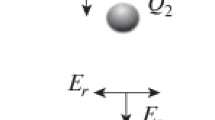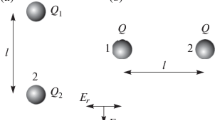Abstract
We report on the results of analytic and numerical investigations of spectral characteristics of the stochastic (thermal) motion of two charged particles in the anisotropic electric field of a trap. We propose analytic relations for the spectral density of displacements in such a system with homogeneous and inhomogeneous heat sources, including the spectral densities for each particle, as well as for their total and mutual displacements. The resulting relations have been verified by numerical simulation of the problem.






Similar content being viewed by others
REFERENCES
Photon Correlation and Light Beating Spectroscopy, Ed. by H. Z. Cummins and E. R. Pike (Plenum, New York, 1974).
J. Frenkel, Kinetic Theory of Liquids (Oxford Univ., London, 1946; Nauka, Leningrad, 1975).
R. Balescu, Equilibrium and Nonequilibrium Statistical Mechanics (Wiley Interscience, Chichester, 1975).
A. A. Ovchinnikov, S. F. Timashev, and A. A. Belyi, Kinetics of Diffusion-Controlled Chemical Processes (Khimiya, Moscow, 1986) [in Russian].
O. S. Vaulina, O. F. Petrov, V. E. Fortov, A. G. Khrapak, and S. A. Khrapak, Dusty Plasmas: Experiment and Theory (Fizmatlit, Moscow, 2009) [in Russian].
Complex and Dusty Plasmas, Ed. by V. E. Fortov and G. E. Morfill (CRC, Boca Raton, FL, 2010).
A. V. Timofeev and B. N. Shvilkin, Sov. Phys. Usp. 19, 149 (1976).
Yu. P. Raizer, M. N. Shneider, and N. A. Yatsenko, Radio-Frequency Capacitive Discharges (CRC, Boca Raton, FL, 1995).
O. S. Vaulina, Phys. Plasmas 24, 023705 (2017).
O. S. Vaulina, J. Exp. Theor. Phys. 124, 839 (2017).
O. S. Vaulina, Europhys. Lett. 115, 10007 (2016).
O. S. Vaulina, S. A. Khrapak, O. F. Petrov, and A. P. Nefedov, Phys. Rev. E 60, 5959 (1999).
R. A. Quinn and J. Goree, Phys. Rev. E 61, 3033 (2000).
O. Vaulina, S. Khrapak, A. A. Samarian, and O. F. Petrov, Phys. Scr. T 84, 292 (2000).
O. S. Vaulina and K. G. Adamovich, J. Exp. Theor. Phys. 106, 955 (2008).
O. S. Vaulina, K. G. Adamovich, O. F. Petrov, and V. E. Fortov, J. Exp. Theor. Phys. 107, 313 (2008).
E. A. Lisin, R. A. Timirkhanov, O. S. Vaulina, O. F. Petrov, and V. E. Fortov, New J. Phys. 15, 053004 (2013).
O. S. Vaulina and E. A. Lisin, Phys. Plasmas 16, 113702 (2009).
V. E. Fortov, O. F. Petrov, O. S. Vaulina, and K. G. Koss, JETP Lett. 97, 322 (2013).
G. A. Hebner, M. E. Riley, and K. E. Greenberg, Phys. Rev. E 66, 046407 (2002).
O. S. Vaulina and I. E. Drangevski, Phys. Scr. 73, 577 (2006).
Yu. P. Raizer, Gas Discharge Physics (Springer, Berlin, 1991; Nauka, Moscow, 1987).
O. S. Vaulina and E. A. Sametov, J. Exp. Theor. Phys. 127, 350 (2018).
Yu. L. Klimontovich, Statistical Physics (Nauka, Moscow, 1982; Harwood Academic, New York, 1986).
A. A. Voronov, Theory of Automatic Control (Vyssh. Shkola, Moscow, 1986), Part 2 [in Russian].
E. A. Lisin and O. S. Vaulina, J. Exp. Theor. Phys. 115, 947 (2012).
E. A. Lisin, O. S. Vaulina, and O. F. Petrov, J. Exp. Theor. Phys. 124, 678 (2017).
I. I. Lisina, E. A. Lisin, O. S. Vaulina, and O. F. Petrov, Phys. Rev. E 95, 013202 (2017).
I. I. Lisina and O. S. Vaulina, Europhys. Lett. 103, 55002 (2013).
O. S. Vaulina, K. G. Adamovich, and I. E. Dranzhevskii, Plasma Phys. Rep. 31, 562 (2005).
A. Melzer, V. A. Schweigert, and A. Piel, Phys. Rev. Lett. 83, 3194 (1999).
V. Steinberg, R. Sütterlin, A. V. Ivlev, and G. Morfill, Phys. Rev. Lett. 86, 4540 (2001).
G. A. Hebner, M. E. Riley, and B. M. Marder, Phys. Rev. E 68, 016403 (2003).
A. A. Samarian, S. V. Vladimirov, and B. W. James, Phys. Plasmas 12, 022103 (2005).
M. Kroll, J. Schablinski, D. Block, and A. Piel, Phys. Plasmas 17, 013702 (2010).
A. K. Mukhopadhyay and J. Goree, Phys. Rev. E 90, 013102 (2014).
H. Jung, F. Greiner, O. H. Asnaz, J. Carstensen, and A. Piel, Phys. Plasmas 22, 053702 (2015).
M. Chen, M. Dropmann, B. Zhang, L. S. Matthews, and T. W. Hyde, Phys. Rev. E 94, 033201 (2016).
Z. Ding, K. Qiao, J. Kong, L. S. Matthews, and T. W. Hyde, Plasma Phys. Control. Fusion 61, 055004 (2019).
Funding
This study was supported in part by the Russian Foundation for Basic Research (project no. 18-38-20175) and the Program of the Presidium of the Russian Academy of Sciences.
Author information
Authors and Affiliations
Corresponding authors
Additional information
Translated by N. Wadhwa
Appendices
APPENDIX A
To find the correlators of velocities and displacements in the system defined by Eqs. (1), (2), we note that the correlators of random force Fb1(2) satisfy equations
where V1(2) = dξ1(2)/dt are the velocities of particles per degree of freedom. (Here and below in Appendix A, angle brackets 〈 〉 indicate averaging over time for t → ∞.) Considering that 〈ξ1V1〉 = 〈ξ2V2〉 ≡ 0 and 〈V1(2)Fb1(2)〉 = ν\(T_{{1(2)}}^{0}\) for motion of particles in closed trajectories, where \(T_{{1(2)}}^{0}\) is the temperature of heat sources, we can write the equations for particle velocity and displacement correlators in form [9, 10]
Here, δT1(2) = \(T_{{1(2)}}^{0}\) – T1(2) and T1(2) = M〈\(V_{{1(2)}}^{2}\)〉 is the doubled kinetic energy of stochastic motion of particles.
Solving Eqs. (A.1)—(A.4), we obtain the energy valance equation in system (1a), (1b); this balance sets in at \(T_{1}^{0}\) ≠ \(T_{2}^{0}\) and leads to a redistribution of the stochastic kinetic energy between particles [9, 10]:
as well as to the following relations for the correlators of velocities and displacements of particles:
APPENDIX B
Any solution F(t) to problem (1), (2) can be written in the form of superposition
In this case, quantity C0 ≡ A1 = 2〈\(\xi _{{1(2)}}^{2}\)〉 for function 〈\(\Delta _{{1(2)}}^{2}\)(t)〉 (see formula (A.7) in Appendix A and [23]). To determine coefficients Ci (i = 1, 2, 3, 4), we can use the initial conditions of the problem: F(0) = 0, dF(0)/dt = 0, d2F(0)/dt2 ≡ A2 = 2T1(2)/M, d3F(0)/dt3 ≡ A3 = 2ν\(T_{{1(2)}}^{0}\)/M [4]. Then we can write the following system of equations for coefficients Ci:
This gives
With account for the roots of the characteristic equation, we can write system (B.6)–(B.9) as
If the particles have the same temperature (\(T_{1}^{0}\) = \(T_{2}^{0}\) ≡ T), we have T1(2) = \(T_{{1(2)}}^{0}\). Consequently,
Rights and permissions
About this article
Cite this article
Sametov, E.A., Lisin, E.A. & Vaulina, O.S. Spectral Characteristics of Stochastic Motion in the System of Two Interacting Particles. J. Exp. Theor. Phys. 130, 463–470 (2020). https://doi.org/10.1134/S1063776120020089
Received:
Revised:
Accepted:
Published:
Issue Date:
DOI: https://doi.org/10.1134/S1063776120020089




